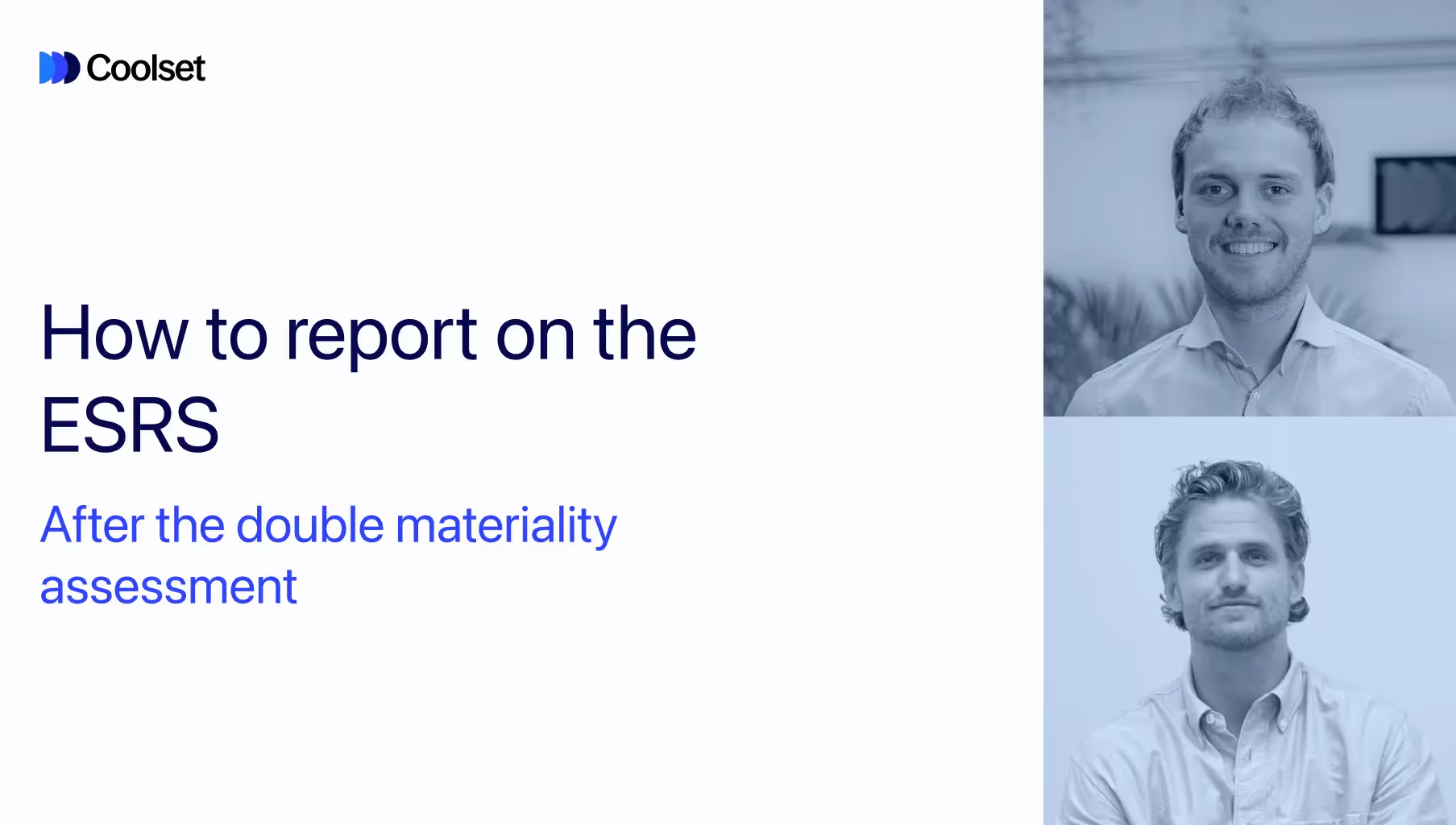
Disclaimer: Latest EUDR developments
On 21 October, the European Commission proposed targeted changes to the EU Deforestation Regulation (EUDR). These adjustments aim to make the rollout smoother without changing the regulation’s overall goals.
Key points from the proposal:
We're closely monitoring the development and will update our content accordingly. In the meantime, read the full explainer here.
As with any new set of rules, wrapping your head around the terminology and requirements can feel overwhelming. That’s why understanding CSRD reporting best practices is crucial—not just for meeting compliance but for crafting reports that truly reflect your sustainability journey and resonate with stakeholders.
In this blog post, we’ll recap the CSRD, highlight the risks of poor reporting, and share key CSRD reporting best practices to help you navigate the process confidently. Plus, we’ll spotlight some standout examples of recent CSRD reports to guide you along the way.
The CSRD is the EU's latest initiative to boost transparency and accountability in corporate sustainability reporting. It expands the scope of the previous Non-Financial Reporting Directive (NFRD), providing a more solid framework for assessing and comparing companies' environmental, social, and governance (ESG) performance.
As part of the European Green Deal, the CSRD plays a key role in helping the EU meet its ambitious target of becoming the first climate-neutral continent by 2050, while aligning with the Paris Agreement's goal of limiting global warming to below 1.5°C.
While CSRD reporting is a valuable opportunity for companies to showcase their commitment to the environment and enhance their market position, it comes with significant costs—and mismanagement can make those costs skyrocket.
From executive briefings and leadership training to IT systems, cross-department training, system integrations, legal counsel, and audits, the price tag adds up quickly. For instance, the EFRAG estimates that yearly auditing costs for limited assurance alone range from 0.013% to 0.026% of revenue. That’s €13,000 to €26,000 per year for every €10 million in revenue. Note that the
If your report isn’t up to standard, you won’t just face expensive rework—you'll also deal with higher compliance and audit fees. Keep in mind that the Omnibus Proposal is changing the way CSRD is set to be audited.

While the Omnibus Proposal isn't final, we expect the fines and timelines to change. However, the following penalties were previously introduced by different EU member states for companies that didn't comply with CSRD:

Now that we've covered the risks of poor reporting, let’s focus on some key tips to help you get your reports right and ensure compliance.
Early data collection is essential for producing comprehensive reports. The sooner you start gathering data on your company’s ESG impacts, the more time you have to identify gaps across teams and refine company-wide sustainability strategies.
Many businesses find that initial data collection uncovers gaps that require significant attention, so the earlier you begin, the better equipped you’ll be to meet the stringent standards of CSRD.
The complexity of CSRD reporting demands a team (or individual, depending on your company size) with expertise in sustainability and ESG reporting. This group, or person will conduct double materiality assessments, coordinate data collection, and ensure compliance with frameworks like the European Sustainability Reporting Standards (ESRS).
Having this expertise in-house is important to produce reports that not only meet regulatory standards but also align with your long-term business strategy.
The growing demand for talent makes this investment even more critical. According to LinkedIn's Global Climate Talent Stocktake 2024, global demand for green talent has increased by 11.6% from 2023 to 2024, while supply only grew by 5.6%.
This widening gap means competition for green-skilled professionals is heating up, and businesses without a dedicated team could fall behind. Investing in talent early can help your company avoid delays and ensure that your sustainability goals are met without unnecessary costs or compliance risks.
One of the most critical aspects of CSRD compliance is conducting a double materiality assessment. This mandatory first step ensures your report focuses on the sustainability topics that truly matter to your business.
Topics can be considered material from two perspectives: impact materiality—how your business affects the environment and society—and financial materiality—how sustainability factors can influence your company’s financial performance.
By understanding and sharing these impacts, companies can create reports that truly benefit stakeholders and help investors and governments make informed decisions.
For more guidance, download our free double materiality assessment guide or watch our latest webinars to walk you through the process.
{{custom-cta}}
CSRD compliance is a team effort that involves collaboration across various departments and stakeholders. Engaging a broad range of voices—employees, investors, and suppliers— ensures your report reflects diverse perspectives.
By actively involving stakeholders and sharing their input openly, you build trust and create a report that speaks directly to the concerns of those who matter most to your business.
Working knowledge of EU and global frameworks supporting credible, audit-ready reporting is key to getting CSRD compliance right. These frameworks make sure your reporting is clear, consistent, and easy to compare, both within Europe and globally.
The CSRD requires companies to follow the ESRS, the main framework for ensuring reporting is consistent across industries.
The EU Taxonomy helps businesses show how their activities support the EU's environmental goals. For instance, in the environmental section of a CSRD report, companies need to disclose how their actions align with the EU Taxonomy Regulation (Regulation 2020/852).
Companies are also encouraged to adopt global standards like the OECD Guidelines for Multinational Enterprises, which add a broader ethical dimension. Together, these frameworks help businesses meet both European and international expectations for sustainability and responsible practices. For insights on how companies are using the CSRD delay to align with global standards and improve ESG readiness, read our full analysis here
The CSRD introduces a range of new rules, from third-party audits to detailed disclosures on governance and social impacts. It’s crucial to understand CSRD requirements to avoid common mistakes. Unlike the NFRD, which allowed more flexibility, the CSRD has specific formatting and auditing standards that must be followed.
Here are some key CSRD requirements to keep in mind:
Note that the Omnibus Proposal, which was published on February 26th 2025, will change a number of these requirements.
Many forward-thinking companies have already begun aligning with the CSRD, and some of their reports offer great insights into CSRD reporting best practices for others to follow. Below are four standout examples of CSRD reports that are making an impact by going beyond compliance:
Vandemoortele, a Belgian food company specializing in bakery products and margarines, sets a high standard in sustainability reporting.
Its report stands out for its thoroughness. Its double materiality assessment took six months and involved a detailed process, including an internal longlist of 200 IROs refined through surveys and interviews with 1800 internal and 117 external stakeholders.
They held 10 focus groups and 22 interviews to discuss IRO thresholds and evaluated risks and opportunities. Their transparency in explaining this process makes the report highly credible.
You can access it here.
H+H International, a leading manufacturer of building materials, delivers a clear and well-organized sustainability report.
They break down exactly where each ESRS data point is covered, making it easy for stakeholders to find what they need. The report uses straightforward language, making it accessible even to non-experts.
You can access it here.
Scan Global Logistics, a global logistics and supply chain management company, emphasizes stakeholder engagement in their sustainability report.
They break down IROs at the sub-topic level, consulting stakeholders to understand specific concerns, and provide a detailed overview of the IROs they considered. This approach ensures the report reflects genuine input, not just top-down decisions.
You can access it here.
Ørsted, a global leader in renewable energy, particularly offshore wind, produces a highly visual and accessible sustainability report.
Its strong use of visuals makes complex information easier to digest while offering a clear breakdown of their sustainability impact. The report is user-friendly and guides stakeholders through their sustainability efforts from double materiality assessments to future goals.
You can access it here.
With investors requiring extensive non-financial KPIs and companies integrating ESG risks and opportunities into their long-term strategy, it's more important than ever to get it right. Trying to manage the process manually can be time-consuming, increase the chance of errors, and lead to higher costs.
That’s why many companies are turning to CSRD compliance software to simplify the process. Tools like Coolset guide you through the entire CSRD compliance process, helping you create audit-ready reports that meet the latest standards. Our software saves time, reduces errors, and ensures your reports follow all CSRD reporting best practices.
Don’t leave compliance to chance. See Coolset in action with our self-guided demo below or request a personalized walkthrough from one of our product experts today.
{{product-tour-injectable}}
A webinar based on real-life examples and best practices
